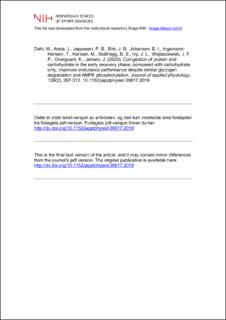| dc.contributor.author | Dahl, Marius | |
| dc.contributor.author | Areta, José | |
| dc.contributor.author | Jeppesen, Per Bendix | |
| dc.contributor.author | Birk, Jesper B. | |
| dc.contributor.author | Johansen, Egil Ivar | |
| dc.contributor.author | Ingemann-Hansen, Thorsten | |
| dc.contributor.author | Mette, Hansen | |
| dc.contributor.author | Skålhegg, Bjørn Steen | |
| dc.contributor.author | Ivy, John L. | |
| dc.contributor.author | Wojtaszewski, Jorgen | |
| dc.contributor.author | Kristian, Overgaard | |
| dc.contributor.author | Jensen, Jørgen | |
| dc.date.accessioned | 2021-03-12T10:38:41Z | |
| dc.date.available | 2021-03-12T10:38:41Z | |
| dc.date.created | 2021-02-01T13:08:17Z | |
| dc.date.issued | 2020 | |
| dc.identifier.citation | Journal of applied physiology. 2020, 129(2), 297-310. | en_US |
| dc.identifier.issn | 8750-7587 | |
| dc.identifier.uri | https://hdl.handle.net/11250/2733114 | |
| dc.description | I Brage finner du siste tekst-versjon av artikkelen, og den kan inneholde ubetydelige forskjeller fra forlagets pdf-versjon. Forlagets pdf-versjon finner du på journals.physiology.org / In Brage you'll find the final text version of the article, and it may contain insignificant differences from the journal's pdf version. The definitive version is available at journals.physiology.org | en_US |
| dc.description.abstract | The present study compared the effects of postexercise carbohydrate plus protein (CHO+PROT) and carbohydrate (CHO)-only supplementation on muscle glycogen metabolism, anabolic cell signaling, and subsequent exercise performance. Nine endurance-trained males cycled twice to exhaustion (muscle glycogen decreased from ~495 to ~125 mmol/kg dry wt) and received either CHO only (1.2 g·kg−1·h−1) or CHO+PROT (0.8/0.4 g·kg−1·h−1) during the first 90 min of recovery. Glycogen content was similar before the performance test after 5 h of recovery. Glycogen synthase (GS) fractional activity increased after exhaustive exercise and remained activated 5 h after, despite substantial glycogen synthesis (176.1 ± 19.1 and 204.6 ± 27.0 mmol/kg dry wt in CHO and CHO+PROT, respectively; P = 0.15). Phosphorylation of GS at site 3 and site 2+2a remained low during recovery. After the 5-h recovery, cycling time to exhaustion was improved by CHO+PROT supplementation compared with CHO supplementation (54.6 ± 11.0 vs. 46.1 ± 9.8 min; P = 0.009). After the performance test, muscle glycogen was equally reduced in CHO+PROT and CHO. Akt Ser473 and p70s6k Thr389 phosphorylation was elevated after 5 h of recovery. There were no differences in Akt Ser473, p70s6k Thr389, or TSC2 Thr1462 phosphorylation between treatments. Nitrogen balance was positive in CHO+PROT (19.6 ± 7.6 mg nitrogen/kg; P = 0.04) and higher than CHO (−10.7 ± 6.3 mg nitrogen/kg; P = 0.009). CHO+PROT supplementation during exercise recovery improved subsequent endurance performance relative to consuming CHO only. This improved performance after CHO+PROT supplementation could not be accounted for by differences in glycogen metabolism or anabolic cell signaling, but may have been related to differences in nitrogen balance. | en_US |
| dc.language.iso | eng | en_US |
| dc.subject | Akt/PKB | en_US |
| dc.subject | exercise | en_US |
| dc.subject | glycogen synthase | en_US |
| dc.subject | nitrogen balance | en_US |
| dc.subject | protein synthesis | en_US |
| dc.title | Coingestion of protein and carbohydrate in the early recovery phase, compared with carbohydrate only, improves endurance performance despite similar glycogen degradation and AMPK phosphorylation | en_US |
| dc.type | Peer reviewed | en_US |
| dc.type | Journal article | en_US |
| dc.description.version | acceptedVersion | en_US |
| dc.source.pagenumber | 297-310 | en_US |
| dc.source.volume | 129 | en_US |
| dc.source.journal | Journal of applied physiology | en_US |
| dc.source.issue | 2 | en_US |
| dc.identifier.doi | 10.1152/japplphysiol.00817.2019 | |
| dc.identifier.cristin | 1885021 | |
| dc.description.localcode | Institutt for fysisk prestasjonsevne / Department of Physical Performance | en_US |
| cristin.ispublished | true | |
| cristin.fulltext | original | |
| cristin.fulltext | postprint | |
| cristin.qualitycode | 1 | |
